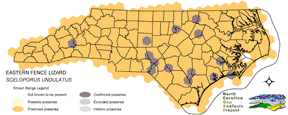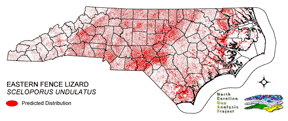
| Taxa: |
| Order: |
| Family: |
| Reptilia |
| Squamata |
| Phrynosomatidae |
| NatureServe Global Rank: |
| NatureServe State (NC) Rank: |
| G5 |
| S5 |
| Federal Status: |
| NC State Status: |
| --- |
| --- |


| Land Unit |
| US Fish & Wildlife Service |
| US Forest Service |
| US National Park Service |
| US Department of Defense |
| NC State Parks |
| NC University System |
| NC Wildlife Res. Com. |
| NC Forest Service |
| NC Div. of Coastal Mgmt. |
| Local Governments |
| Non-Governmental Org. |
| Other Public Lands |
| Private Lands |
| GAP Status 1-2 |
| All Protected Lands |
| Statewide |
| Hectares |
| 12,866.40 |
| 69,710.04 |
| 70,093.08 |
| 14,326.29 |
| 19,134.27 |
| 11,301.30 |
| 44,393.67 |
| 6,367.35 |
| 864.99 |
| 2,610.27 |
| 4,738.95 |
| 2,322.54 |
| 3,276,874.89 |
| 76,970.37 |
| 257,247.93 |
| 3,535,604.04 |
| Acres |
| 31,793.56 |
| 172,257.23 |
| 173,203.74 |
| 35,401.03 |
| 47,281.80 |
| 27,926.12 |
| 109,699.13 |
| 16,347.13 |
| 2,137.44 |
| 6,450.12 |
| 11,710.20 |
| 5,739.12 |
| 8,097,332.62 |
| 190,810.96 |
| 636,286.42 |
| 8,737,279.22 |
| % of Dist. on |
| Prot. Lands |
| 5.0 % |
| 27.1 % |
| 27.1 % |
| 5.6 % |
| 7.4 % |
| 4.4 % |
| 17.0 % |
| 2.5 % |
| 0.3 % |
| 1.8 % |
| 1.8 % |
| 0.8 % |
| < 0.1 % |
| 29.9 % |
| ----- |
| ----- |
| % of Dist. on |
| All Lands |
| 0.4 % |
| 2.0 % |
| 2.0 % |
| 0.4 % |
| 0.5 % |
| 0.3 % |
| 1.3 % |
| 0.2 % |
| < 0.1 % |
| < 0.1 % |
| 0.1 % |
| < 0.1 % |
| 92.7 % |
| 2.2 % |
| ----- |
| ----- |
|
Occurs throughout the state although scarce at higher elevations and absent from the outer banks (Martof et al 1980). It has been recorded as high as 5,100 feet, though more commonly found in valley areas and lower slopes of the mountains (Palmer & Braswell 1995). These lizards prefer xeric open woods and woodland edges, building sites, slab piles, fences, and rocky places (Martof et al 1980, Mitchell 1994). Generally humid areas and dense, shady forests are avoided (Martof et al 1980, Palmer & Braswell 1995). Palmer and Braswell (1995) state the fence lizard is 'most common in relatively dry, open woodlands of pines and hardwoods, especially in places affording an abundance of sunlight.' Sandhills and scrub oak communities are also used (Palmer & Braswell 1995). Nests are dug oft times in sandy soils or sawdust piles, 5 to 15 cm deep, also burrows beneath rotten logs are used (Martof et al 1980, Palmer & Braswell 1995). Fence lizards often bask on the sides of trees, logs, wood fences, and old buildings during the day, and withdraws into tree holes, under tree bark, or in rock crevices at night (Mitchell 1994, Palmer & Braswell 1995). They prey on a variety of invertebrates, which are generally attacked after being spotted from a perch site (Mitchell 1994). NATURE SERVE GLOBAL HABITAT COMMENTS: Habitat varies geographically; arboreal, terestrial, or saxicolous. Usually in sunny/open situations. Underground or in crevices when inactive. Eggs are laid in soil/underground, can tolerate submersion in river water for at least several hours (J. Herpetol. 26:338-341). |
| Code | Name | Description | NC Natural Heritage Program Equivalent |
| 121 | Maritime Pinelands | Loblolly forests and woodlands of the outer coastal plain. | Estuarine Fringe Loblolly Pine Forest |
| 17 | Maritime Forests and Hammocks | Maritime forests and woodlands dominated by live or sand laurel oak. Estuarine Fringe forests dominated by loblolly pine. | Coastal Fringe Evergreen Forest, Maritime Deciduous Forest, Maritime Deciduous Forest |
| 42 | Xeric Longleaf Pine | Sandhills including a range of longleaf pine density from predominantly wiregrass, scrub oak dominated to true longleaf pine woodland. This does not include mesic or saturated flatwood types. | Xeric Sandhill Scrub, Pine/Scrub Oak Sandhill, Coastal Fringe Sandhill |
| 46 | Xeric Oak - Pine Forests | Mixed forest dominated by yellow pines with white or northern red oaks co-dominating. | Pine Oak Heath |
| 232 | Xeric Pine-Hardwood Woodlands and Forests | Mixed forest dominated by yellow pines with drier oaks including southern red, post, and chestnut oaks. | Dry Oak Hickory Forest |
| 222 | Piedmont Dry-Mesic Pine Forests | Loblolly dominated forests resulting from succession following clearing. This type occurs on all moisture regimes following disturbance with the exception of the extremely xeric sites. | No equivalent |
| 382 | Dry Mesic Oak Pine Forests | Mixed forests of the coastal plain and piedmont. Includes loblolly pine with white, southern red and/or post oak and loblolly with water oak. On basic sites of the piedmont, eastern red cedar may co-occur with post, black, and blackjack oaks. | Dry Mesic Oak Hickory Forest, Xeric Hard Pan Forest, Chestnut Oak Forest, Dry Mesic Oak Hickory Forest, Dry Oak Hickory Forest |
| 220 | Piedmont Xeric Pine Forests | Dry to xeric pine forests dominated by Virginia pine, shortleaf pine or Eastern Red Cedar. | Pine Oak Heath |
| 226 | Piedmont Xeric Woodlands | Generally post and blackjack oak dominated woodlands. White ash and pignut hickory can be found in combination with Eastern red cedar on glades. | Xeric Hardpan Forest |
| 20 | Coniferous Regeneration | Regenerating pine stands. Predominantly loblolly pine, but slash and longleaf stands occur as well. | No equivalent |
| 21 | Coniferous Cultivated Plantation (natural / planted) | Managed pine plantations, densely planted. Most planted stands are loblolly, but slash and longleaf occur as well. | No equivalent |
| 202 | Residential Urban | Includes vegetation interspersed in residential areas. Includes lawns, mixed species woodlots, and horticultural shrubs. Vegetation accounts for between 20 - 70% of the cover. | No equivalent |
| 203 | Urban Low-Intensity Developed | Highly developed areas with vegetation accounting for < 20% of the cover. | No equivalent |
| 528 | Appalachian Xeric Pine Forest | Pine forests and woodlands on xeric sites. A variety of pines, including Virginia, Shortleaf, Eastern White Pine, Table Mountain and Pitch pine. Often small areas of dense pine within a matrix of Xeric Oak-Pine Forests. | Pine Oak Heath |
| 529 | Appalachian Xeric Mixed Forest | Mixed forests with Virginia, Shortleaf, Eastern White Pine, Table Mountain and Pitch pines in combination with xeric oak species. Oaks include, white, Southern Red, black, and rock chestnut. | Pine Oak Heath |
|
Cole, C. J. 1983. Specific status of the North American fence lizards, SCELOPORUS UNDULATUS and SCELOPORUS OCCIDENTALIS, with comments on chromosome variation. Am. Mus. Novitates (2768):1-13.
Sites, J. W., Jr., et al. 1992. A review of phylogenetic hypotheses for lizards of the genus SCELOPORUS (Phrynosomatidae):implications for ecological and evolutionary studies. Bull. Am. Mus. Nat. Hist. (213):1-110. Parker, W. S. 1994. Demography of the fence lizard, SCELOPORUS UNDULATUS, in northern Mississippi. Copeia 1994:136-152. Mitchell, J. C. 1994. The reptiles of Virginia. Washington, DC: Smithsonian Institution Press. Palmer, W. M., and A. L. Braswell. 1995. Reptiles of North Carolina. North Carolina State Museum of Natural Sciences, University of North Carolina Press, Chapel Hill, North Carolina. Smith, H. M., and D. Chizar. 1989. The subspecific identity of the population of SCELOPORUS UNDULATUS sympatric with S. OCCIDENTALIS. Bull. Maryland Herp. Soc. 25(4):143-150. Fitch, H. S. 1970. Reproductive cycles of lizards and snakes. Univ. Kansas Museum Natural History Miscellaneous Publication 52:1-247. Minton, S. A., Jr. 1972. Amphibians and reptiles of Indiana. Indiana Academy Science Monographs 3. v + 346 pp. Behler, J. L., and F. W. King. 1979. The Audubon Society field guide to North American reptiles and amphibians. Alfred A. Knopf, New York. 719 pp. Martof, B. S., W. M. Palmer, J. R. Bailey, and J. R. Harrison, III. 1980. Amphibians and reptiles of the Carolinas and Virginia. University of North Carolina Press, Chapel Hill, North Carolina. 264 pp. Hammerson, G. A. 1982. Amphibians and reptiles in Colorado. Colorado Division of Wildlife, Denver. vii + 131 pp. Ashton, R. E., Jr., and P. S. Ashton. 1985. Handbook of reptiles and amphibians of Florida. Part two. Lizards, turtles & crocodilians. Windward Pub., Inc., Miami. 191 pp. Tinkle, D. W., and A. E. Dunham. 1986. Comparative life histories of two syntopic sceloporine lizards. Copeia 1986:1-18. Stebbins, R. C. 1985. A Field Guide to Western Reptiles and Amphibians. Second Edition. Houghton Mifflin Company, Boston, Massachusetts. xiv + 336 pp. Smith, H. M., D. Chizar, and W. Marmie. 1991. Peripheral variation in the lizard SCELOPORUS OLIVACEUS, and its hybridization with S. UNDULATUS. Bull. Maryland Herp. Soc. 27(3):128-145. |
For more information please contact them at:
NC-GAP Analysis Project
Dept. of Zoology, NCSU
Campus Box 7617
Raleigh, NC 27695-7617
(919) 513-2853
www.basic.ncsu.edu/ncgap